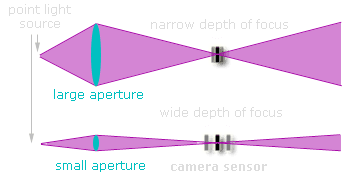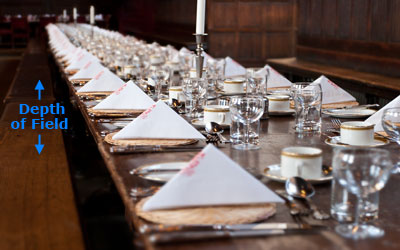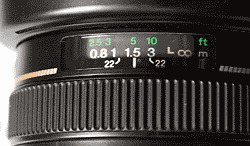Depth of field refers to the range of distance that
appears acceptably sharp. It varies depending on camera type, aperture and
focusing distance, although print size and viewing distance can also influence
our perception of depth of field.
The depth of field does not abruptly change from sharp to
unsharp, but instead occurs as a gradual transition. In fact, everything
immediately in front of or in back of the focusing distance begins to lose
sharpness — even if this is not perceived by our eyes or by the resolution of
the camera.
CIRCLE
OF CONFUSION

Since there is no critical point of transition, a more
rigorous term called the "circle of confusion" is used to define how
much a point needs to be blurred in order to be perceived as unsharp. When the
circle of confusion becomes perceptible to our eyes, this region is said to be
outside the depth of field and thus no longer "acceptably sharp." The
circle of confusion above has been exaggerated for clarity; in reality this
would be only a tiny fraction of the camera sensor's area.

When does the circle of confusion become perceptible to
our eyes? An acceptably sharp circle of confusion is loosely defined as one
which would go unnoticed when enlarged to a standard 8x10 inch print, and
observed from a standard viewing distance of about 1 foot.
At this viewing distance and print size, camera
manufacturers assume a circle of confusion is negligible if no larger than 0.01
inches (when enlarged). As a result, camera manufacturers use the 0.01 inch
standard when providing lens depth of field markers (shown below for f/22 on a
50mm lens). In reality, a person with 20/20 vision or better can distinguish
features 1/3 this size, and so the circle of confusion has to be even smaller
than this to achieve acceptable sharpness throughout.
A different maximum circle of confusion also applies for
each print size and viewing distance combination. In the earlier example of
blurred dots, the circle of confusion is actually smaller than the resolution
of your screen for the two dots on either side of the focal point, and so these
are considered within the depth of field. Alternatively, the depth of field can
be based on when the circle of confusion becomes larger than the size of your
digital camera's pixels.
Note that depth of field only sets a maximum value for
the circle of confusion, and does not describe what happens to regions once
they become out of focus. These regions are also called "bokeh," from
Japanese (pronounced bo-ké). Two images with identical depth of field may have
significantly different bokeh, as this depends on the shape of the lens
diaphragm. In reality, the circle of confusion is usually not actually a
circle, but is only approximated as such when it is very small. When it becomes
large, most lenses will render it as a polygonal shape with 5-8 sides.
CONTROLLING DEPTH OF FIELD
Although print size and viewing distance influence how
large the circle of confusion appears to our eyes, aperture and
focusing distance distance are the two main factors that determine how big the
circle of confusion will be on your camera's sensor. Larger apertures (smaller
F-stop number) and closer focusing distances produce a shallower depth of
field.
CLARIFICATION:
FOCAL LENGTH AND DEPTH OF FIELD
Note that focal length has not been listed as influencing
depth of field, contrary to popular belief. Even though telephoto lenses appear to create a much shallower depth of field, this
is mainly because they are often used to magnify the subject when one is unable
to get closer. If the subject occupies the same fraction of the image (constant
magnification) for both a telephoto and a wide angle lens, the total depth of field is virtually* constant with
focal length! This would of course require you to either get much closer with a
wide angle lens or much further with a telephoto lens, as demonstrated in the
following chart:
Focal Length (mm)
|
Focus Distance (m)
|
Depth of Field (m)
|
10
|
0.5
|
0.482
|
20
|
1.0
|
0.421
|
50
|
2.5
|
0.406
|
100
|
5.0
|
0.404
|
200
|
10
|
0.404
|
400
|
20
|
0.404
|
Note: Depth of field calculations are at f/4.0 on a
camera with a 1.6X crop factor,
using a circle of confusion of 0.0206 mm.
using a circle of confusion of 0.0206 mm.
Note how there is indeed a subtle change for the smallest
focal lengths. This is a real effect, but is negligible compared to both
aperture and focusing distance. Even though the total depth of field is
virtually constant, the fraction of the depth of field which is in front of and
behind the focus distance does change with focal length, as demonstrated below:
Distribution of the Depth of Field
|
||
Focal Length (mm)
|
Rear
|
Front
|
10
|
70.2 %
|
29.8 %
|
20
|
60.1 %
|
39.9 %
|
50
|
54.0 %
|
46.0 %
|
100
|
52.0 %
|
48.0 %
|
200
|
51.0 %
|
49.0 %
|
400
|
50.5 %
|
49.5 %
|
This exposes a limitation of the traditional DoF concept:
it only accounts for the total DoF and not its distribution around the focal
plane, even though both may contribute to the perception of sharpness. Note how
a wide angle lens provides a more gradually fading DoF behind the focal plane
than in front, which is important for traditional landscape photographs.
Longer focal lengths may also appear to have a
shallower depth of field because they enlarge the background relative to the
foreground (due to their narrower angle of view). This can make an out of focus
background look even more out of focus because its blur has become enlarged.
However, this is another concept entirely, since depth of field only describes
the sharp region of a photo — not the blurred regions.
On the other hand, when standing in the same place and
focusing on a subject at the same distance, a longer focal length lens will
have a shallower depth of field (even though the pictures will frame the
subject entirely differently). This is more representative of everyday use, but
is an effect due to higher magnification, not focal length.
Depth of field also appears shallower for SLR cameras
than for compact digital cameras, because SLR cameras require a longer focal
length to achieve the same field of view.
. On the other hand, at high magnification the traditional DoF
calculation becomes inaccurate due to another factor: pupil magnification. This
reduces the DoF advantage for most wide angle lenses, and increases it for
telephoto and macro lenses. At the other limiting case, near the hyperfocal
distance, the increase in DoF arises because the wide angle lens has a greater
rear DoF, and can thus more easily attain critical sharpness at infinity.
In order to calculate the depth of field, one needs to
first decide on an appropriate value for the maximum allowable circle of
confusion. This is based on both the camera type (sensor or film size), and on
the viewing distance / print size combination. Needless to say, knowing what
this will be ahead of time often isn't straightforward.
DEPTH
OF FOCUS & APERTURE VISUALIZATION
Another implication of the circle of confusion is the
concept of depth of focus (also called the "focus spread"). It
differs from depth of field because it describes the distance over which light
is focused at the camera's sensor, as opposed to the subject:

Diagram depicting depth of focus versus camera aperture.
The purple lines comprising the edge of each shaded region represent the
extreme angles at which light could potentially enter the aperture. The
interior of the purple shaded regions represents all other possible angles.
The key concept is this: when an object is in focus,
light rays originating from that point converge at a point on the camera's
sensor. If the light rays hit the sensor at slightly different locations
(arriving at a disc instead of a point), then this object will be rendered as
out of focus — and increasingly so depending on how far apart the light rays
are.



No comments:
Post a Comment